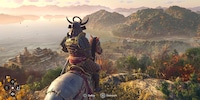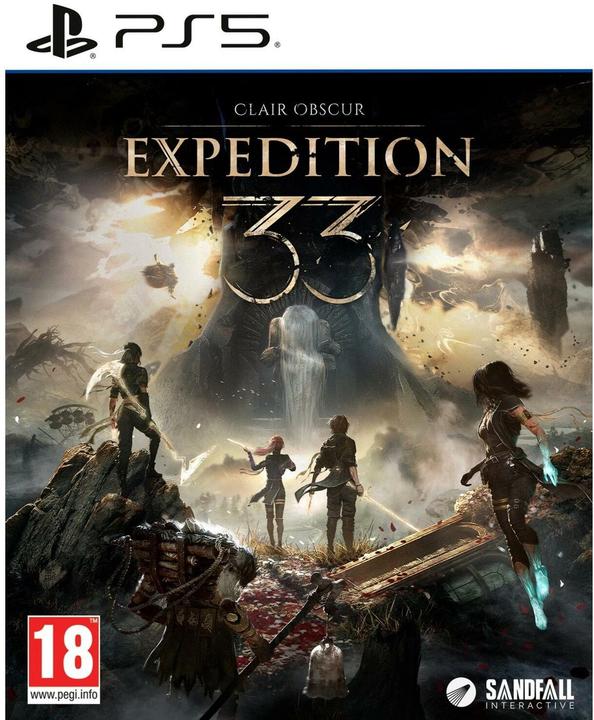

Clair Obscur: Expedition 33’s my JRPG of the year
If you’re a fan of Japanese role-playing games or a Francophile, Clair Obscur: Expedition 33 is a must. Developed by a small French development team, the game impresses with both its presentation and its turn-based combat system.
My head bobs in time with the orchestral soundtrack, underscored by deep bass. I grip my controller tightly with sweaty hands, because the Dualliste’s about to attack again. I’ve already used up my healing and revival potions in the ten-minute battle. Because when the mighty enemy strikes with his swords, my health points just melt away. At least I know his attack patterns by now. Now, with Maelle, I first have to parry «normally» twice, then jump once, and counterattack immediately after that before I have to defend myself against a particularly powerful attack in another way. I succeed, and Maelle unleashes a devastating counterattack that finally finishes off the enemy.
Oof.
This happens more than once in Clair Obscur: Expedition 33 – and not just against the bosses. The turn-based combat system – which the studio Sandfall Interactive supplements with time-based interactions – is one of the game’s highlights. And there are plenty more. For example, the fantastic world, which offers a fresh setting with its French influences. Or the exciting, likeable characters woven into a convoluted story that ultimately feels coherent and emotional. Or the thrilling, bombastic soundtrack, which builds from climax to climax. I’m blown away!
A story with multiple twists and revelations
Every year at the same time, the gigantic Paintress awakens from her sleep and writes a number on her monolith. All people who have exceeded the number’s age pass away. So, every year, an expedition sets out to put an end to the Paintress’ reign.
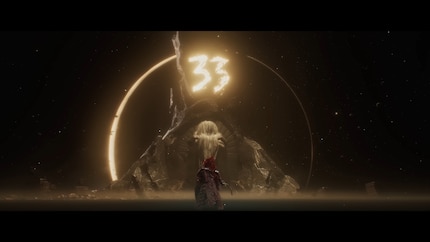
Source: Sandfall Interactive
In the game, I’m part of Expedition 33. At the beginning, I control Gustave across the rooftops of Lumière. The city is strongly reminiscent of Paris during the Belle Époque. It looks beautiful – everything’s decorated with flowers. But beauty’s deceptive. I quickly learn that everyone here’s in constant mourning. Because the Gommage is imminent. In a few moments, the Paintress will inscribe the number 33 on her monolith, and many of Expedition 33 will lose loved ones forever. This makes loss the central theme of the game.
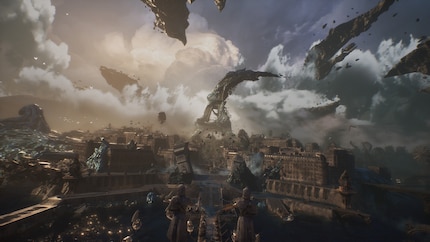
Source: Sandfall Interactive
Immediately after the Gommage, Expedition 33 sets off for the monolith. Naturally, nothing goes according to plan, and the thrown-together team of Gustave, Maelle, Lune, and Sciel must explore the continent on their own – Lumière is on an island. This demonstrates how little the inhabitants know about the world of Clair Obscur outside of their city. They’re essentially discovering it with you.
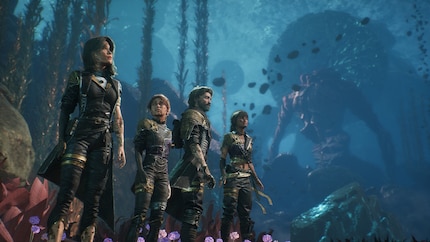
Source: Sandfall Interactive
It’s clear there’ll be some revelations. Many of them are hinted at, but they aren’t at all clear from the outset. I really enjoyed the main story, primarily due to the characters.
Before I get to that, though, a few words about the game’s scope. The credits rolled after about 29 hours. Sandfall Interactive itself says the main story takes 30 hours to play. I did a few side quests, but I rushed for the review. More side quests should keep me busy for another 20 hours. That makes Clair Obscur: Expedition 33 short for a role-playing game. That doesn’t bother me. Quite the opposite. I like games that aren’t too long, and 30 hours is far from short. Plus there’s the fact that the story’s so coherent and doesn’t drag on unnecessarily.
Wonderful characters
Gustave, Maelle, Lune, and Sciel know each other very well. Of course, they trained together for the expedition. Their relationships are fascinating. Gustave’s like a big brother and mentor to Maelle, who lost her parents to a Gommage at an early age. Gustave also has a close relationship with Lune – it seems there used to be some romantic feelings here – while Sciel’s a colleague he occasionally jokes with. These relationships develop over the course of the story, and you learn more about the characters’ lives and motivations.
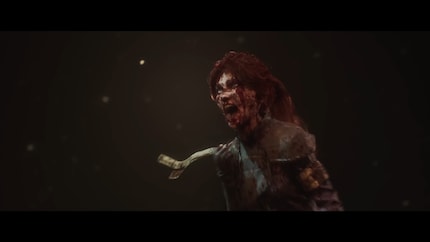
Source: Sandfall Interactive
I do have some criticism of the characters and their relationships: they only work through Gustave. While the three women are friends and fight for a common cause, their relationships with each other feel lacking.
I get to know the characters both in the main story and in the camp, which I can access at any time on the world map. This is where I can engage in optional dialogue. Fortunately, things aren’t always serious – they’re also occasionally in the mood for jokes.
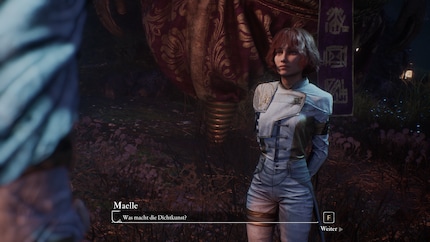
Source: Sandfall Interactive
The mystical chicken-like creature Esquie provides some particularly funny scenes. When I try to recruit it – it serves as a means of transportation on the world map – it gets into a neighbourly argument with the turtle François, who’s apparently stolen one of his favourite stones. This stone gives him the ability to swim. The two share a cave, and there’s a degree of humour when an oversized stone turtle complains to the giant stuffed chicken that it’s constantly sending hooligans after it. It’s wonderfully absurd, especially because I then have to fight François, which is an easy task.
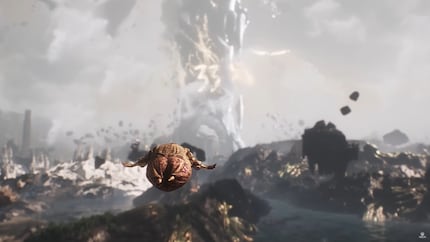
Source: Sandfall Interactive
Later in the game, other characters join the group, such as the Gestral Monoco. Gestrals are some of the few creatures on the continent who are well-disposed toward humans. They love combat and consider it a form of meditation – not a bad trait in an environment where enemy creatures Nevrons are constantly lurking. Monoco only agrees to join Expedition 33 after being promised plenty of exciting battles.
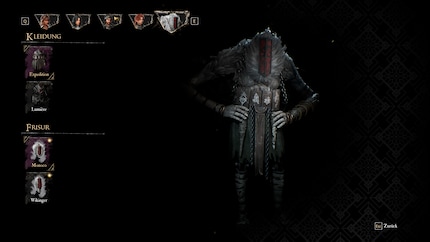
Source: Sandfall Interactive
There are also supporting characters, but they play an even smaller role than in other role-playing games. This is fitting because it reinforces the impression of the desolate and sparsely populated world of Clair Obscur and it leaves more time for the actual characters and their relationships.
Presentation with light and shadow
The name Clair Obscur says it all: the team at Sandfall Interactive plays with light and shadow in its presentation. Strong contrasts are a key focus. Many environments look like paintings, and many of them are also surreal. Flying Waters, for example, is both underwater and not underwater. It’s both beautiful and disturbing.

Source: Sandfall Interactive
The environments are really diverse. A Caribbean holiday vibe awaits me on the optional Gestral Beaches, complete with minigames. On the rugged Stone Wave Cliffs, I explore a completely different beach landscape, where shipwrecks also float in the sky. Frozen Hearts offers a winter landscape, while Sirène has a Middle Eastern feel, complete with a giant dancer. I repeatedly found myself lost in the simultaneous beauty and hopelessness of the environments. That’s how it should be.
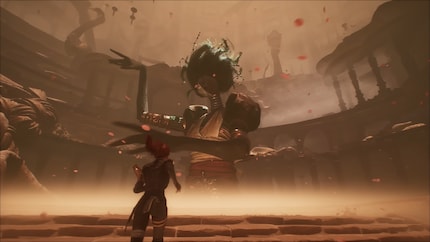
Source: Sandfall Interactive
But it’s not just the environment that’s diverse; so are the many enemies. Their designs could come from a children’s picture book sometimes and a nightmare at others. They range in size from knee height to several hundred metres tall. Battles such as the one against the Dualliste I described earlier are burned into my memory. The optional battles against Mime also provide constant variety, especially visually. Awesome.
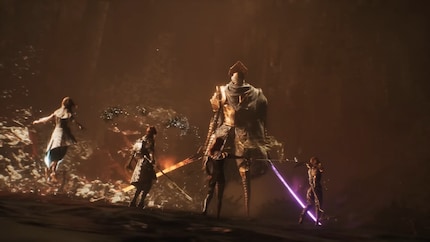
Source: Sandfall Interactive
But there are also things that aren’t so good. In my test version, pop-ins were a common occurrence. Also, while the cutscenes are beautifully animated, the characters’ dialogue in the camps seems as wooden as I’d expect of Bethesda. What’s more, the lips are occasionally out of sync with the French and English dialogue. However, Sandfall Interactive’s promised to fix many of these issues with a patch for release.
Speaking of voice acting, it’s great in both versions. Ben Starr – known for Final Fantasy XVI – voices one of the main characters, and even well-known Hollywood star Andy Serkis is on board as Renoir. I still preferred the French version, though. If only because «putain de merde» sounds better without an English accent.
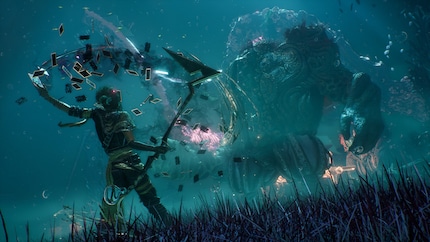
Source: Sandfall Interactive
The soundtrack’s no less opulent than the visuals. It was created by Lorien Testard, who, like Sandfall Interactive, hasn’t previously worked on a video game. The French influence is consistently audible. In Lumière, the music almost makes me feel like I’m on the Champs Élysées. The diverse arrangements of the battle music add oomph, especially during the boss fights. The fact that it races from climax to climax doesn’t bother me. On the contrary – the soundtrack beautifully complements the story, which constantly outdoes itself.
The best for last: the combat system
In terms of gameplay, much of Clair Obscur: Expedition 33 is the same as other Japanese role-playing games:
- I equip my characters with weapons and armour – called Pictos
- After battles, I receive experience points, levelling me up
- I distribute the status points I receive and learn new attacks
- Battles are turn-based
So far, so JRPG. Where the game stands out from others is its time-based interactions. For example, when I attack with Maelle, I have to press the A button on my controller at specific times. If I do it perfectly, my chance of a critical hit increases. The interactions during enemy attacks are more important than during my own attack.
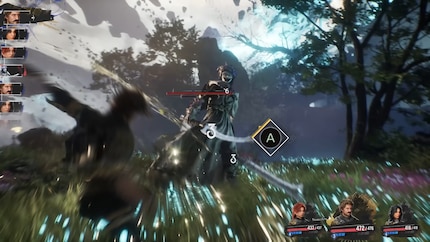
Source: Sandfall Interactive
For example, I can dodge or parry by pressing the corresponding button at the right time. The enemies’ attacks usually consist of multiple attacks, so I have to memorise their patterns precisely. Even on normal difficulty, they do a lot of damage, and the time window’s short. If I manage to block every blow, the characters will launch counterattacks.
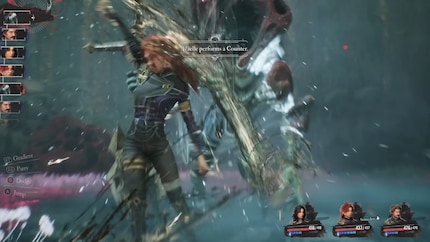
Source: Sandfall Interactive
This sounds simple at first, but it adds a whole new dimension to turn-based combat, which I – as a Metroidvania fan – find incredibly enjoyable. It requires precision and quick reactions. It’s as if my two favourite genres have had a baby that I can now nurture and care for.
But the combat system’s still fun beyond the time-critical interactions. Each character has their own unique traits in combat. Monoco, for example, doesn’t learn his abilities through the skill tree – he collects the bones of Nevrons, allowing him to take over their attacks. There’s also a system of masks that enhance attacks accordingly. Magic attacks are stronger with the magic mask and so on. Lune, however, collects elemental patches, which also enhance attacks. I have to put together a powerful team so I’m prepared as well as possible, especially against bosses.
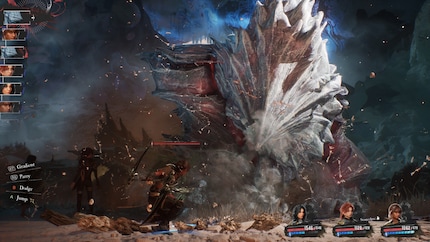
Source: Sandfall Interactive
If you’re one of those people who prefer not to actively fight, you can also play the game on «Easy». This way, characters don’t receive as much damage and you don’t need to block. Those who want a real challenge can also set the game to «Hard» or start a «New Game+» after completing the game for the first time.
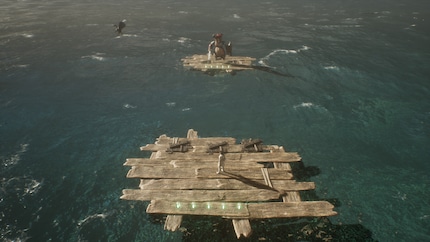
Source: Sandfall Interactive
My criticism of the gameplay’s about exploration rather than the combat system. I have to complete platforming sections, especially in the minigames. In my opinion, they’re not very well done. The fact that certain dungeons – especially early in the game – are like a tube also bothers me. But none of these details detract from the overall enjoyment of the game.
Clair Obscur: Expedition 33 was provided to me by Kepler Interactive. I tested the PC version. The game’s out now for PS5, Xbox Series X/S and PC.
In a nutshell
A JRPG gem from Europe
The Sandfall Interactive team behind Clair Obscur: Expedition 33 consists of just 30 people. Why mention that? Most other games of this size are made by much larger teams. But you can’t tell. Quite the opposite. The story, presentation, and gameplay are brilliant, even leaving genre leaders like Final Fantasy XVI in its wake. If I had to create a top five list of my favourite role-playing games, Clair Obscur: Expedition 33 would be on it. This is also due to the great twist of merging turn-based combat with time-critical interactions. While that sounds simple, it meaningfully expands on a system I’m already familiar with.
Add to that a stunning world inspired by Belle Époque France, combined with mythical creatures in an apocalyptic world. If that’s not enough, the team at Sandfall Interactive wraps it all up in an emotional story about loss and relatable, lovable characters. The whole thing’s topped off with one of the most beautiful soundtracks I’ve heard in years.
My only criticisms are the frequent pop-ins and somewhat wooden-looking characters outside of cutscenes. Gameplay-wise, there’s not much to complain about. I don’t like the occasional platforming sequences or the controls in minigames, but we’re talking minor quibbles here.
In short, Clair Obscur: Expedition 33’s a masterpiece and shows how role-playing games with turn-based combat can still feel fresh in 2025. It’s quite possibly my JRPG of the year.
Pro
- Likeable characters
- Exciting story
- Great presentation
- Fantastic soundtrack
- Innovative, turn-based combat system
Contra
- Numerous pop-ins
- Annoying platformer sequences
- Character models outside of cutscenes seem wooden

From big data to big brother, Cyborgs to Sci-Fi. All aspects of technology and society fascinate me.
Which films, shows, books, games or board games are genuinely great? Recommendations from our personal experience.
Show all

